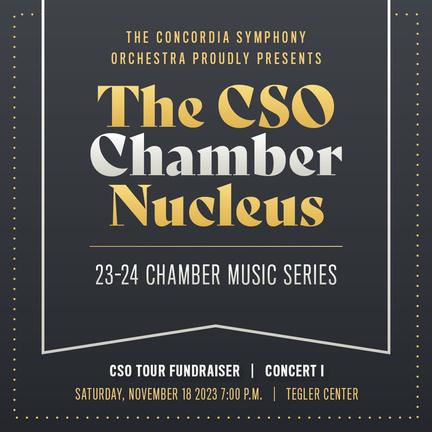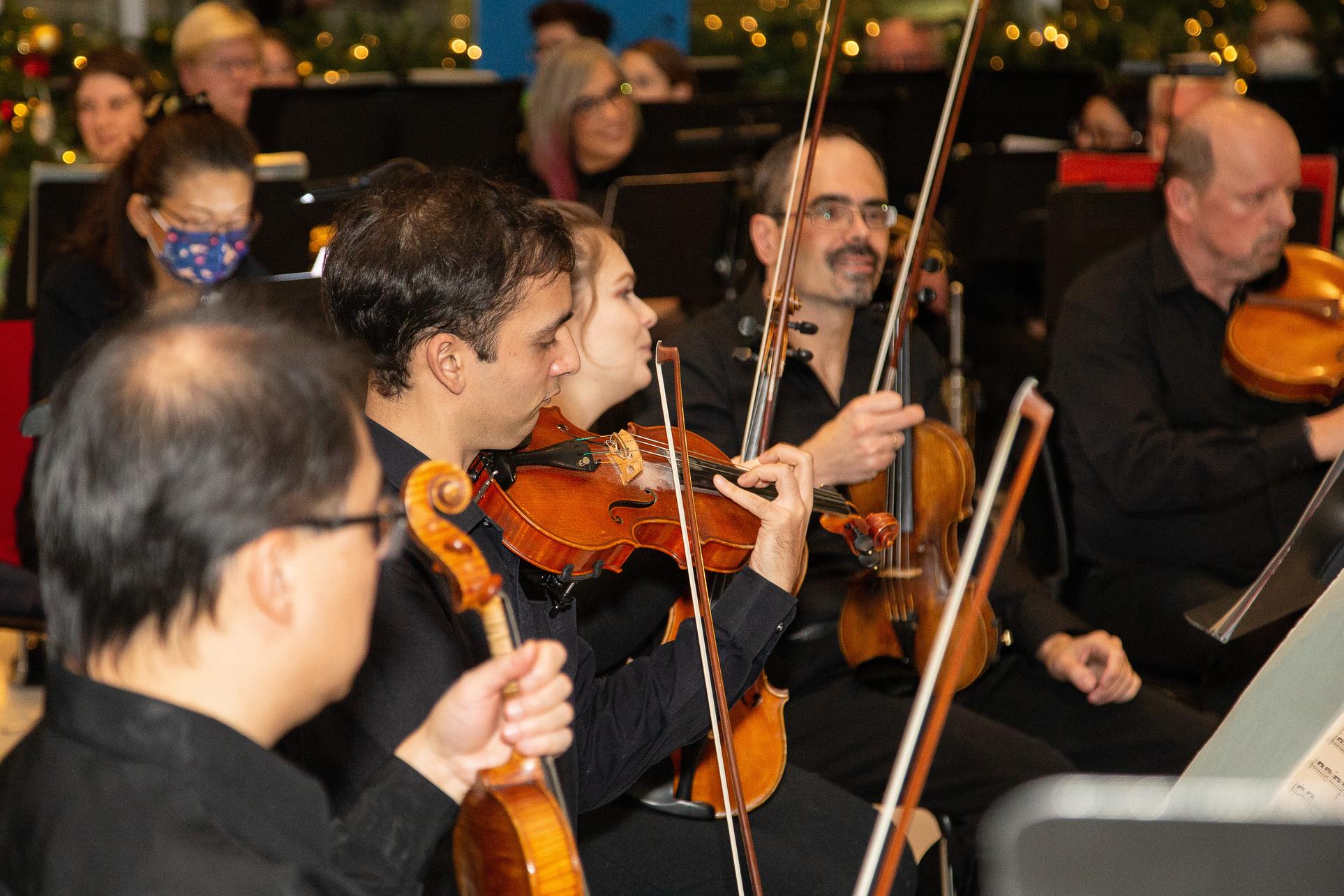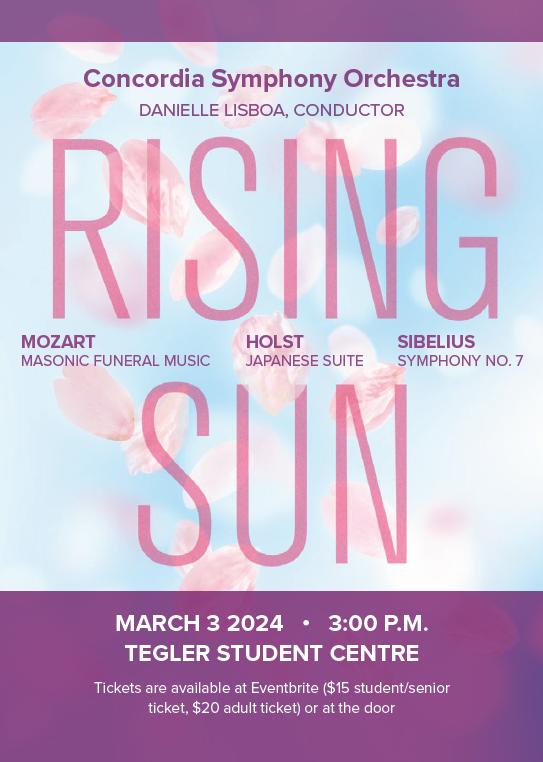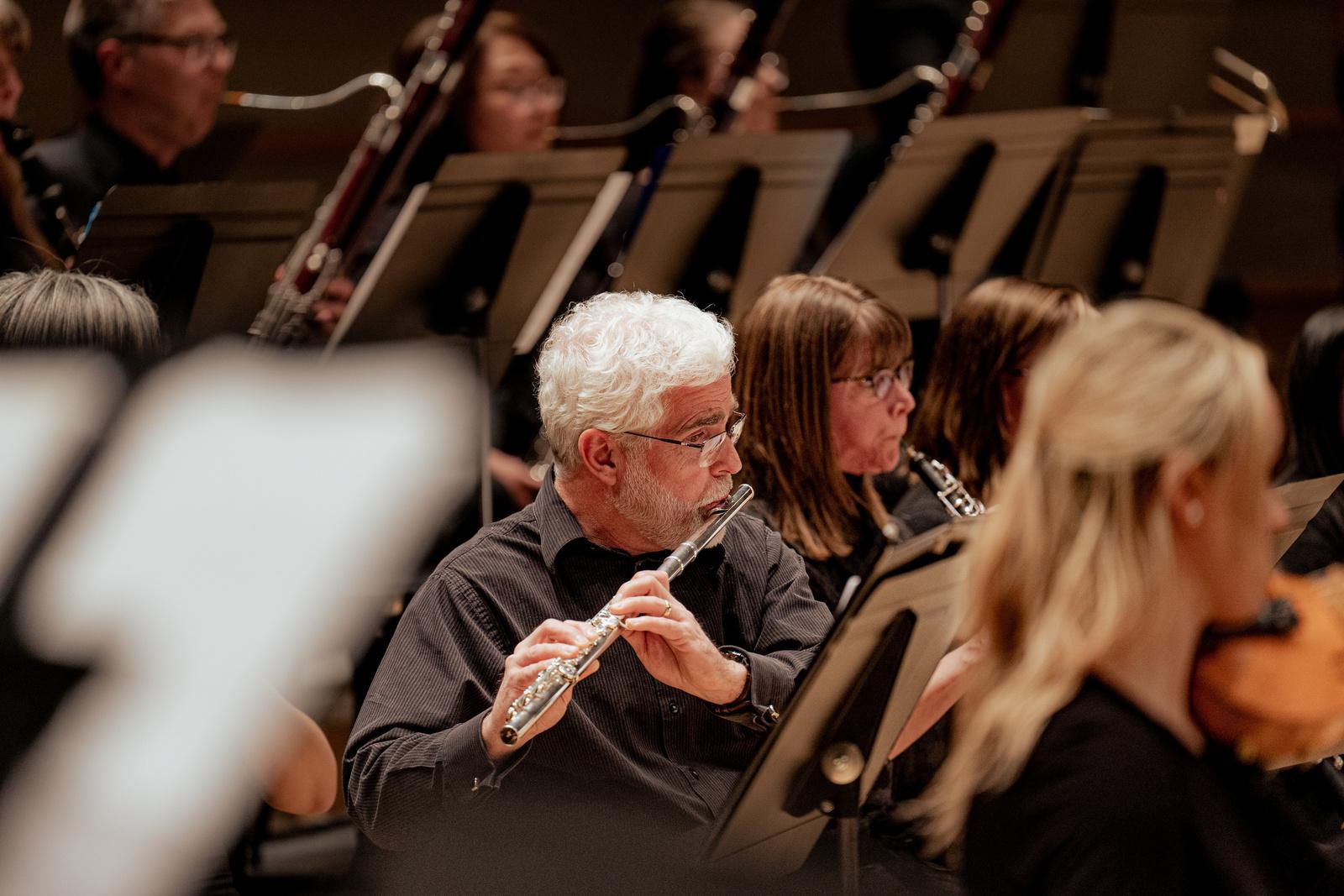ProgramNotes
By Jennifer Gregory
Masonic Funeral Music in C minor, K. 477
Mozart was commissioned to compose the Masonic Funeral Music to honor the passing of two fellow lodge and Freemasonry members (Georg August von Mecklenburg-Sterliz and Count Ferenc Esterházy). Written in 1785, the composition is scored for a small orchestra, featuring strings, woodwinds, and brass instruments The orchestration is rich and textured, and Mozart’s use of the key of C minor adds darkness and intensity to help convey the themes of loss and remembrance while adhering to the ceremonial structure of a Masonic funeral service.
The Masonic Funeral Music opens with somber woodwinds and brass which sets a mournful tone then the strings join playing a slow and expressive melody. The subsequent sections of the composition evoke more moments of mourning and reflection at varying levels of intensity The music builds to a powerful climax before gradually subsiding, leading to a poignant and quiet conclusion.
Symphony No. 7, Op. 105
Symphony No. 7 in C major, Op. 105, is the final symphony composed by Finnish composer Jean Sibelius. Completed in 1924, this one movement symphony is unique as it breaks from Sibelius’ previous symphonies which typically have multiple movements The work’s continuous structure unfolds organically by stating and transforming various themes and motifs throughout the composition. Sibelius employs a rich orchestration using various orchestral colors and textures to create a contemplative mood.
The symphony begins with a mysterious and brooding atmosphere, gradually building tension and intensity. Throughout the work, Sibelius explores various moods and emotions, incorporating moments of drama, melancholy, and triumph. The use of cyclic themes, where musical ideas from earlier in the piece return and undergo transformation, adds to the overall sense of unity. The final section of the symphony is noteworthy for its powerful and majestic character, bringing the work to a triumphant conclusion.
Japanese Suite Op. 33
Holst wrote this work at the request of dancer Michio Ito, who wanted a composition derived from traditional Japanese tunes to perform to. Since Holst was unfamiliar with Japanese folk music, Ito had to whistle several tunes to provide thematic materials for the suite. Though the suite contains folk tunes, musically the Japanese Suite, is solidly within the “western” classical music tradition and uses similar harmonies and textures found in Holst’s other repertoire. While we know the piece was premiered in London on September 1, 1919, there is no record on whether the work was ever used for a dance performance.
The suite is structured in six movements. The first movement (Prelude: Song of the Fisherman) introduces the tune with a solo bassoon This is followed by the lively “Dance of the Wolves” which takes its influence on Japanese ceremonial music. The whimsical and carefree third movement, “Dance of the Marionette” is entirely of Holst’s creation.
The Intermezzo “The Dance Under the Cherry Tree” returns to Japanese music origins with a reflective mood. Next is the “Dance of the Buffoons: The Wrestlers” which captures the intensity of these sporting competitions. Finally, the “Dance of the Wolves” is reprised to conclude the work.
VIOLINI
FrankHo
RaymondLeung*
AllanNelson
ArwenThysse
SvitlanaRemniakova
RebekahNey
LaszloSzajko
VIOLINII
MarieKrejcar
LinneaBarisoff
HaroldSteinbrenner
SongGee
VIOLA
DarrellSoetaert
AnaSchultz
AlanDunn
JoeDupuis
CELLO
JohnFedor
RyanHoffman
JuliaDarby
KatarinaLoutas
SharonToronchuk
FrancesElgaard
BASS
DanteWright*
EvanStewart
ColinCampbell
THISEVENING’SPERFORMERS
FLUTE/ PICCOLO
JenniferGregory
RockLarochelle
OBOE/ENGLISH HORN
StephanieWong*
NatalieDies
CLARINET
AmberCampbell
CindyRichardson
BASSOON
DouglasRidgway
FRENCHHORN
MartinGrasdal
CatherineLabbe
CaralieHeinrichs
SuzanneLangor
TRUMPET
NancyStepney
HeidiSchwonik
ScottWatson
TROMBONE
FentonCorey
KenBurns
TUBA
DavidSalmon
PERCUSSION
JacobKryger
RebeccaBergt*
DouglasVick
HARP
SamanthaSpurrier
*CUEStudent
DanielleLisboa,Conductor
Brazilian-born Danielle Lisboa leads an active career as an orchestral conductor, music educator and scholar, regularly conducting community and professional ensembles. Lisboa holds a doctorate in orchestral conducting from the Eastman School of Music University of Rochester. On arriving in Canada in 2008, she became Orchestra Toronto’s first apprentice conductor, was named assistant conductor two months later and shortly after was appointed the orchestra’s music director and conductor. During her tenure, Lisboa became known for her cutting-edge programming and public engagement Her vision and

dynamic leadership took Orchestra Toronto into new paths for outreach and youth initiatives, including the Marta Hidy Concerto Competition and the popular annual children’s concerts. Two years later she led Bellus Barbari, the Toronto Women’s Symphony Orchestra, in its inaugural Ontario tour. Lisboa currently serves as Associate Professor of Music at Concordia University of Edmonton in the areas of conducting and music theory. Lisboa is former music director and co-founder of the Edmonton Metropolitan Orchestra and continues to maintain an active presence in the community with the Edmonton Philharmonic Orchestra in outreach concerts to local continuing care hospitals and schools. Her current research interests encompass topics of women and leadership on the orchestral podium and analysis and transcription of sacred rituals of native peoples of Brazil with recent partnerships and publications in Portugal and Brazil. Lisboa reinstated the Concordia Symphony Orchestra as a new ensemble in fall of 2017 She spearheaded Concordia’s first operatic project, developed a summer string camp for youth, and a provincial concerto competition. Most recently, she led the Orchestral Training and Leadership workshop to mentor young conductors and orchestral players into leadership roles

THE CSO 23-24 CHAMBER SERIES
CSOChamberNucleusTour Fundraiser
Saturday,March30 7:00p.m.
TeglerCentre Admissionbydonation
THE GLOBAL MUSICIAN TOUR
The CSO Chamber Nucleus proudly presents “Canadian Impressions”- a prime chamber music collection of Canadian soundscapes from coast to coast
JUNE 2024
Switzerland - Austria - Liechtenstein - Italy
CANADIAN IMPRESSIONS
 Moraine Lake - Alberta- Canada
Moraine Lake - Alberta- Canada
Fribourg,Switzerland:June22
starringtheOrchestredelaVilleetdel'UniversitédeFribourg
Dornbirn,Austria:June23
Vaduz,Liechtenstein:June24
Florence,Italy:June28
starringtheOrchestradell'UniversitàdegliStudidiFirenze
Marjan Mozetich (Ontario) Scales of Joy and Sorrow (piano, violin, cello)
Christos Hatzis (Ontario) Old Photographs from “Constantinopla” (piano, violin, cello)
Richard Mascall (Ontario) Petroglyphs (piano quartet)
Pierick Houdy (Québec) Divertissement pour Trompette, Cor, et Piano (piano, horn, and trumpet)
Vivian Fung (Prairies) Birdsong (piano, violin)
Elizabeth Raum (Atlantic Canada) Romance for French Horn and Piano (piano, horn)
The ensemble will also be arranged as a chamber string orchestra for a well-known classic, Elgar's Serenade for Strings
The Nucleus background
Although the Concordia Symphony Chamber Nucleus was developed before the pandemic, the group ended up becoming the main outlet for our musicians to engage and perform with each other during periods of gathering size and venue restrictions between March 2020 to September 2021. Typical rehearsal venues were private backyards (during indoor restrictions), or heated garages during the cold Canadian winter. These small ensemble activities proved vital for the participating musicians as a coping tool during the COVID-19 crisis as they strengthened their bonds in musicmaking. After the pandemic, the orchestra added a parallel Chamber Series to its regular season The CSO Nucleus membership is comprised of CUE faculty, students, alumni, and musicians from the Edmonton community.
The CSO is currently fundraising for its first international tour in 2024. The goal of this initiative is to promote less-known repertoire to a wider audience abroad and to introduce Canadian music to international audiences. Please consider a charitable donation to CSO to support our fundraising efforts. Donations can be made by email at donations@concordia.ab.ca or online using this link.

Note: Donations over $20 will receive a donation receipt. Charitable Registration number is 10696 6468 RR0001










 Moraine Lake - Alberta- Canada
Moraine Lake - Alberta- Canada

